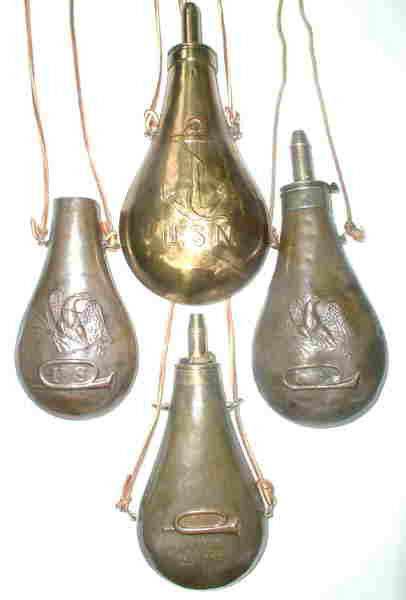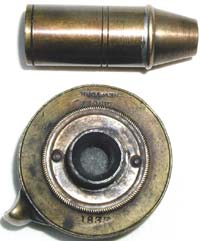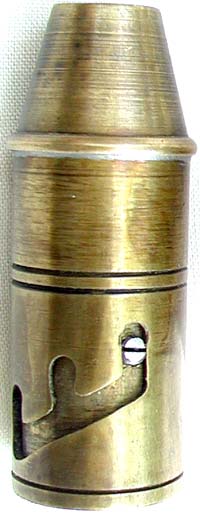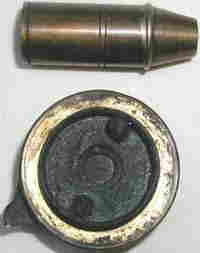|
Part 2 of 3
|
||||
| From May 5 to May 14, 2000, the featured Collector's Item of the Week topic was 3 different examples of the U.S. Peace flask. This week we will be looking at the second of three and three-quarters of other U.S. military copper powder flasks. Part 1 was posted on July 20, 2000. A picture of all these flasks follows: | ||||
|
|
||||
| Top:
An 1845 dated "Fouled Anchor" U.S. Navy flask by Stimpson. (See
August 3 Collector's Item) Center Left: A "topless" 1832 U.S. Rifleman's "Bugle Eagle" flask by Robert Dingee. (This Collector's Item) Center Right: A complete 1833 dated U.S. Rifleman's "Bugle Eagle" flask by Robert Dingee. (This Collector's Item) Bottom: An undated 1825 -27 U.S. Rifleman's "Public Property" flask. (See July 20's Collector's Item)
|
||||
|
|
||||
|
Please note that the definitive work on Powder Flasks, of all types,
is Ray Riling's "The Powder Flask Book" published in
1953. It is a magnificent tome and it is highly unlikely that it will
ever be surpassed in its breadth and study scope of powder flasks.
Therefore, rather than reinvent the wheel, I have paraphrased or repeated
directly herein some of his comments on the subject powder flasks.
I pray to God that I have done right by Mr. Riling and can only belatedly
thank him for the unbelievable effort he put into his book and the
great and lasting knowledge and benefits he passed on to the entire
world.
|
||||
|
|
||||
|
With the exception of the "Fouled Anchor" U.S. Navy flask the official
U.S. government powder flasks were intended to be used only for issue
to Riflemen in the Regular Service and to Militia Units. They may,
of course, have been used irregularly with muskets. However, these
flasks, along with the Hall rifle flask manufactured at the Harper's
Ferry Arsenal and the later "Peace" flasks, were generally meant to
serve the Model 1803, 1814-20 U.S. flintlock rifle, the Model 1814
U.S. flintlock rifle, the Model 1817 flintlock "Common Rifle" and
the percussion conversions thereof plus the U.S. percussion rifle,
Model of 1841. The "Fouled Anchor" navy flask was originally manufactured
for use with the Jenks Navy Carbine and the Ames Boxlock single shot
pistol.
Last week we started with the earliest of the grouping. That was the James Baker "Public Property Flask" of 1825 -1827. This week the featured flasks are Robert Dingee's
|
||||
|
|
||||
|
Robert Dingee, the maker or contractor for the "Bugle Eagle" flask, was listed as an "inspector of green hides" at 96 West in the New York City Directory of 1832-1833. On February 20, 1832 he was awarded a contract for 3,450 copper powder flasks to hold 9 ounces of rifle powder to be supplied with a regulating charger, with the smallest setting to be 70 grains. The cost per flask would be $1.30. He received later contracts for Hall's rifle accoutrements complete with 250 sets of black leather pouches and copper flasks to hold 8 ounces of of powder plus 250 rifle flasks in 1834. In January of 1836 another contract called for 200 rifle flasks of copper carrying 8 ounces with charger top providing a maximum of 100 grains and minimum of 85 grains in loading measurements. In 1837, Dingee would turn down supplying any more flasks as he had experienced a loss upon those he had formerly manufactured. Later contracts for the "new" Peace Flask would then go to Ames and Batty.
|
||||
|
The 1832 flask pictured here does not have it's top and is unmarked.
However the eagle and bugle design is the same as that on the 1832
dated flask pictured in Riling's book. A third flask is pictured in
his book. That flask does not have the U. S. in the loop of the bugle.
Riling offers that it may have been purchased by certain militia units
which equipped their own corps.
|
||||
|
A Major Campbell, quoted in Riling's book states: "The eagle ornament
is of practically the same design as worn by Infantry and Artillery
on belt plates from 1832 to 1836. The bugle is not an accurate representation
of the infantry insignia for the period. Mounted riflemen used a somewhat
similar bugle in 1844 which rested on it's bell." The bugle on this
flask model is much like the one on the Public Property Flask. Both
are without carrying rings and neither are emblematic of U.S. Corp
insignia at the time they were issued. The visual evidence follows:
|
||||
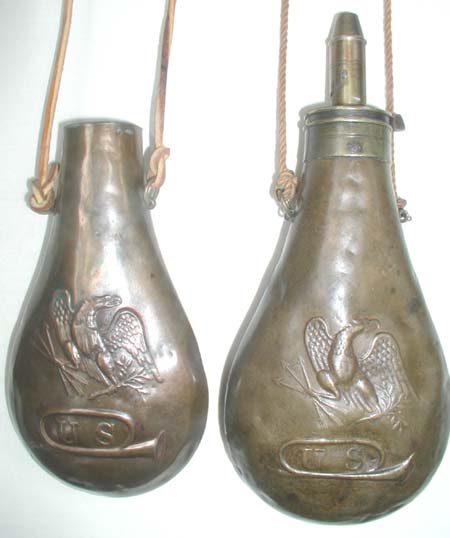
|
||||
|
|
||||
|
The approximate measurements of the 1833 dated flask are 9½"
overall including the 1¾" "regulating" adjustable spout. The
width, at the widest point is 4". The top diameter is 1½".
The bugle stamping is 2-5/8" long by ¾" in height. The inside
bell measurement is 9/16". On the 1832, the bugle stamping is 2-5/8"
long, 15/16" in height with an inside bell measurement of 5/8". Riling
states that the actual average measurements of powder from the chargers
of his 3 samples were 68, 74.5 and 85 grains. The 1833 dated flask
is marked on the top of the collar "R. DINGEE/ NEW-YORK" in 2 lines
directly across from the date of "1833". There are no inspector's
initials, numbers or any other markings. Identical Bugle Eagle stampings
are on both sides of each flask.
|
||||
|
|
||||
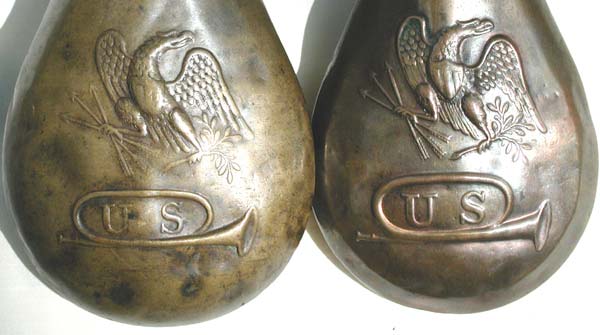
A Photo Comparison Of The Bugle Eagle Stamping
|
||||
|
|
||||
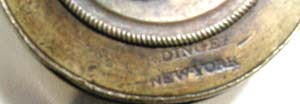
"R DINGEE/NEW-YORK" |
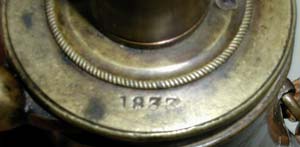
"1833"
|
|||
|
|
||||
|
||||
|
|
||||
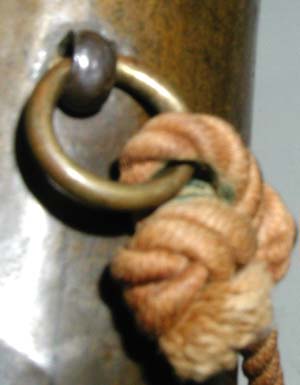
Carrying Ring - Same on Both Flasks
|
||||
|
|
||||
|
|
||||
|
|
||||
|
As stated last week, I hope that everyone likes this series on American
military copper powder flasks both in words and pictures. Full credit
for the descriptions used should be given to Ray Riling along with
our deep gratitude for his epic powder flask book. Once again, my
thanks to Reed Radcliffe, my son, the webmaster of this site.
Next Part 3 of 3 Dave Radcliffe
|
||||
